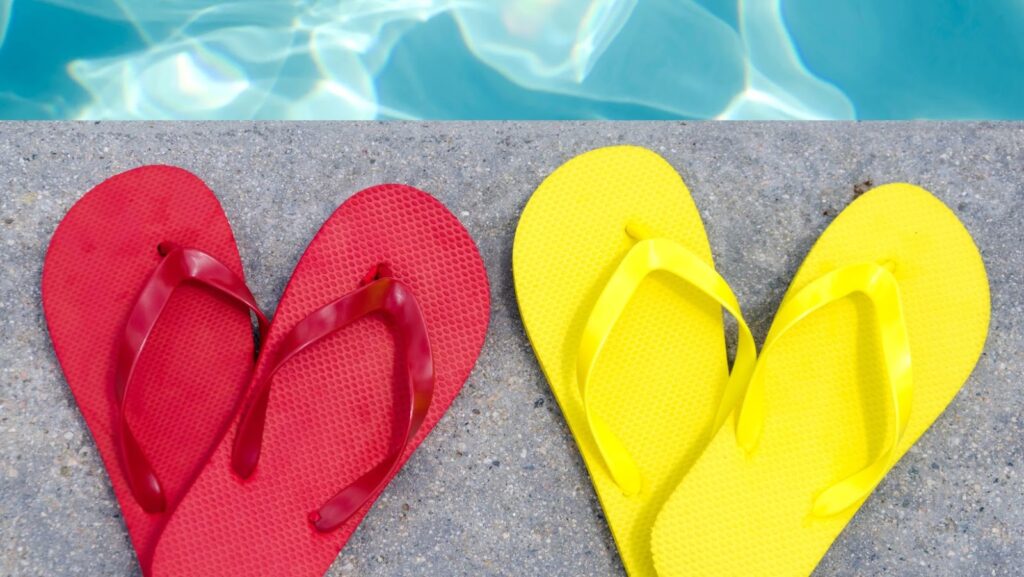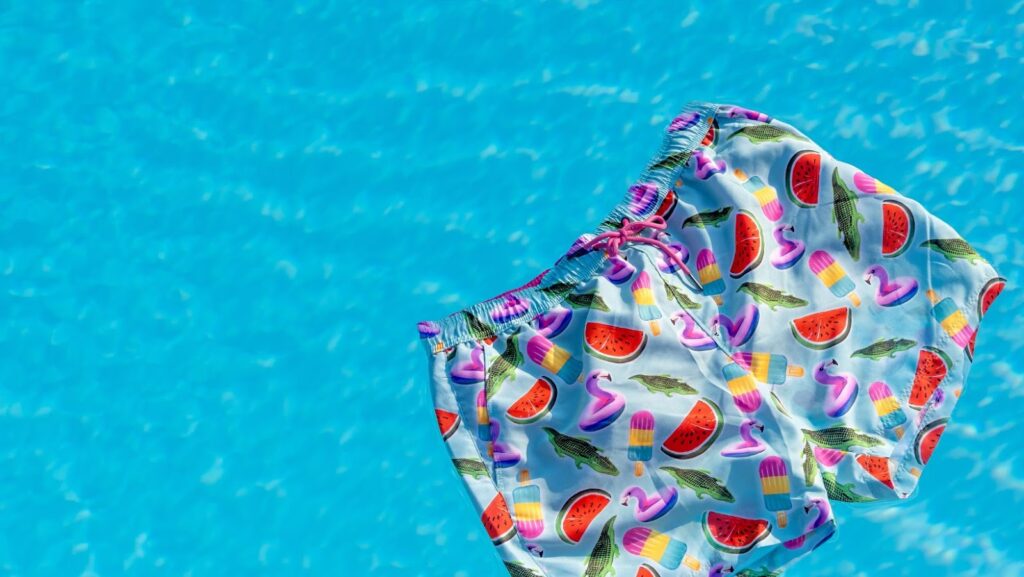To clean your rainbow flip flops effectively, you need to follow this step-by-step guide with the right materials. First, gather the materials needed, then follow the guide to remove dirt and grime from your flip flops with ease. Keep reading to get a comprehensive understanding.
How to Clean Rainbow Flip Flops
To effectively clean your Rainbow flip flops, you will require a few essential items that are readily available at home. These tools will make your cleaning process easier and faster.
- A soft-bristled brush
- A bucket of warm water
- White vinegar or mild dish soap
- A clean towel or cloth
- The appropriate cleaning product for leather or fabric straps depending on the material of your Rainbow flip flops.
It’s vital to note that using harsh chemicals can damage the flip-flops; hence, it is not advisable.
One crucial detail in cleaning rainbow flip flops is avoiding the use of bleach. The use of bleach on the footbed can lead to discoloration. Instead, use a natural stain remover such as vinegar mixed with baking soda to maintain their vibrant colors.
According to experts from Good Housekeeping, it’s essential to let the flip-flops air dry instead of using a dryer or placing them under direct sunlight, which could cause warping or shrinkage.
Did you know that eco-friendly detergents such as Mrs. Meyers Clean Day are also a great option for cleaning Rainbow Flip Flops? Follow these steps and your Rainbow flip flops will be so clean, you’ll feel guilty dirtying them up again.
Step-by-Step Guide
A comprehensive tutorial on how to clean Rainbow Flip Flops is provided below, guiding readers through each step of the process. Follow these six steps for cleaning your rainbow flip flops:
- Start by brushing off the sandals with a soft brush or cloth to remove loose dirt and debris.
- Create a cleaning solution by mixing warm water and a small amount of mild soap in a bowl.
- Dip a sponge or cloth into the cleaning solution and use it to gently scrub the surface of the flip flops, paying close attention to any areas that are particularly dirty or stained.
- Rinse the flip flops thoroughly with clean water to remove any remaining soap residue.
- Pat them dry with a towel or leave them out in the sun to air dry.
- Repeat this cleaning process as often as needed to keep your rainbow flip flops looking good as new.
It is worth noting that some Rainbow Flip Flop products, such as leather sandals, may require special care instructions that differ from those outlined above. Always check the care label on your specific product before attempting any cleaning or maintenance tasks.
One avid user applied this same guide but got carried away and decided to experiment with black dye instead of soap to add more life into her atypical flip flops. Unfortunately, they ended up being ruined entirely beyond repair!
Your rainbow flip flops will thank you for these simple yet necessary materials.
Materials Needed
To gather the required material for cleansing your rainbow flip flops, you would need warm water and mild soap. These supplies would come in handy while following the cleaning routine laid out in the article ‘Rinse the flip flops with warm water (how to clean rainbow flip flops)’.
Warm Water
The hot liquid required for this project entails water warmed to a specific temperature. Appropriate warm water varies depending on the project and can be achieved using a stove or microwave. Ensure the water is not too hot, as this could damage materials being used.
In addition to providing a medium for mixing materials, warm water can also be a key component in some chemical reactions that are necessary for certain projects. It aids in dissolving solid substances and breaking down compounds, making them more malleable and easier to work with.
It is important to note that using cold water instead of warm can lead to inadequate saturation while using boiling hot water may cause damage or deformity of the materials involved in your project. Always use warm water according to instruction.
Trivia: Famed inventor Alexander Graham Bell patented an invention that pre-heated bathwater by sending it through heated coils.
Mild soap may be gentle on your skin, but it won’t be as forgiving on those stubborn greasy stains.
Mild Soap
A gentle cleansing agent is required for some tasks. This compound’s effectiveness can enhance the results while avoiding harm to the materials. A natural and mild cleanser should be used on surfaces sensitive to chemicals or fragile ones susceptible to damage from abrasive cleaners.
A mild soap will assist in removing dirt, grime, and stains from surfaces gently without damaging the colors or the texture. With this type of soap, you may clean items such as clothing, leather goods, old porcelain pieces, antiques and many more objects that require special treatment. Using a mild product with no harsh chemicals allows you to keep the material’s brightness or hue intact.
It is vital to select a mild yet effective soap according to the fabric type or surface that needs cleaning. For instance, never use rough alcohol-based cleaners on delicate crystal containers with painted designs since abrasives are likely to cause permanent damage.
One time, I made a mistake by not using a mild soap when cleaning my delicate wool sweater. It became damaged beyond repair due to the harsh chemical properties of the detergent I used. Choosing a gentler option in this scenario could have saved me from having to acquire another sweater.
Follow these simple steps, and even your DIY-challenged friend can become a master of materials.
Step-by-Step Guide
To clean your Rainbow flip flops, you need a step-by-step guide. Rinse the flip flops with warm water and apply mild soap to remove dirt and grime. Scrub gently in circular motions to avoid any damage to the sandals. Finally, rinse again with warm water and let them air dry before use.
Rinse with Warm Water
Rinsing with mildly-warm water helps to cleanse and rejuvenate the skin.
To rinse with warm water, firstly, wet your face or body with warm water that is slightly above room temperature. 2. use your fingertips or a clean cloth to gently massage the warm water into your skin in circular motions. Finally, rinse off the warm water with some cool or tepid water.
It is important not to use excessively hot or cold water as it can strip your skin of natural oils and cause irritation.
Additionally, using warm water before applying skincare products help to open up pores and allow for maximum absorption of the product.
Pro Tip: Use distilled or filtered water instead of tap water to avoid impurities and harsh minerals on your skin.
Don’t worry, this step won’t cause any drama- just lather, rinse, and repeat (unless you’re a bar of soap, in which case things might get a little messy).
Apply Mild Soap
Using a gentle cleansing solution is recommended to maintain cleanliness and prevent damage to skin. A suitable mild detergent can be used instead of traditional body wash. Apply gentle cleaning solution for better cleaning performance, ensure the product is hypoallergenic, and use warm water. Avoid hot water, which might cause damage or dryness to the skin.
Once you have applied the mild soap, it’s time to rinse it off completely, focusing on any areas that may require special attention. Ensure no residue is left behind after rinsing off the soap. Pay attention to your feet as they can accumulate dead skin cells and dirt easily.
To avoid damage caused by harsh chemicals present in soaps and detergents, it’s best to use natural ingredients such as honey or oatmeal soap for those with sensitive skin. They are formulated with organic materials that cleanse deeply while being gentle enough for daily use.
It is said that bathing with mild soap decreases itching, reduces inflammation and hydrates one’s skin naturally. During ancient times, Greeks and Romans were known for their love of clean bodies and understood the benefits of basic hygiene practices. Bathhouses constructed during those times were equipped with different soaking pools of different temperatures associated with different levels of cleanliness practice; they even had massage tables available for patrons who needed additional relaxation services.
Scrub gently, like you’re washing the face of a cherub, not vigorously cleaning off a crime scene.
Scrub Gently
Gently remove dead skin cells to reveal smoother, glowing skin. Use circular motions and avoid harsh scrubs to prevent irritation. A mild exfoliating product is recommended for sensitive skin.
To properly scrub your skin, start by wetting it with warm water to open up the pores. Apply a small amount of product onto your fingertips and begin massaging in circular motions, working from your forehead down to your chin. Avoid scrubbing too hard on delicate areas such as around the eyes and nose.
Remember to rinse thoroughly with lukewarm water after scrubbing to remove any residue or remaining product. Pat dry with a clean towel instead of rubbing vigorously.
For best results, limit exfoliation to twice a week for normal skin types and once a week for sensitive skin. Over-scrubbing can lead to redness, inflammation, and damage.
Don’t miss out on the benefits of gentle scrubbing – achieve smoother, brighter-looking skin with this simple skincare step. Don’t forget to rinse, unless you want your skin to look like a science experiment gone wrong.
Rinse Again with Warm Water
To ensure thorough cleaning, repeat the process of rinsing with warm water. This final rinse helps to remove any remaining residue or debris from the item being cleaned, leaving it completely clean and fresh.
Step-by-Step Guide:
- Fill a container or sink with warm water.
- Submerge the item in the water and agitate it gently.
- Drain the water and refill with clean warm water.
- Submerge the item again and agitate gently.
- Drain the water and gently shake off excess moisture.
It’s worth noting that this step is particularly important for items like dishes or clothing that come into contact with skin or food, where residual debris can cause irritation or contamination.
A common mistake when rinsing is not changing out the water frequently enough, which can lead to redeposition of dirt or grime onto the item being cleaned. By taking care to perform an additional rinse cycle with clean warm water, you can ensure that your items are truly clean.
I once had a friend who thought she was done washing her dishes after just one rinse cycle with hot soapy water. She later realized that there was still oil residue on her bowls, causing her food to taste odd. After learning about the importance of a final rinse, she never made that mistake again!
Remember, step-by-step does not mean step-on-a-crack-break-your-mother’s-back.
Tips and Precautions
To ensure your rainbow flip flops stay in good condition, you need to take proper care of them. That’s why in this section, we will provide you with some important tips and precautions to follow in order to keep your flip flops looking new for longer. To avoid any damage to your flip flops, we recommend you avoid bleach, hot water, and air dry them in a specific manner.
Avoid Bleach
When considering the selection of cleaning agents, there are a few things to consider. One of the key aspects is to avoid using bleach-like substances.
- It is important to note that bleach can be corrosive for some materials, including certain fabrics and metals.
- Additionally, overuse or incorrect application can lead to long-term damage to surfaces.
- Finally, excessive utilization could result in adverse health effects due to respiratory irritations.
It’s necessary to choose alternate cleaning solutions that are less harmful while still being effective in removing stains and disinfecting surfaces. Provide a better understanding of the potential damages caused by bleach-like substances.
Historically, Bleach was originally developed as an industrial tool before its uses were expanded with time. Its use came into prominence during World War 1 when chlorine gas was employed as a deadly weapon. However, it was not until 1916 when its use became popularized as a household cleaning agent in America.
Why take a hot shower when you can just stand outside on a summer day?
Avoid Hot Water
When it comes to precautions, it is advisable to steer clear of scalding liquids. Hot water can cause severe burns and scalds that can damage the skin’s top-most layer, causing extreme pain, swelling and redness. Using cool or lukewarm water while bathing, washing clothes or dishes can prevent these injuries from occurring.
Apart from injuries, hot water also has side effects on the hair and scalp. Excessive use of hot water while shampooing can strip off natural oils from the scalp and make hair dry and brittle. Instead, it’s recommended to rinse hair with cold or lukewarm water to maintain healthy locks.
It’s essential to avoid exposing infants or young children to hot water, as they are more susceptible to burns than adults due to their thinner skin. To prevent accidents, adjust your hot water system’s temperature below 120°F / 48°C and install anti-scald devices in every sink and shower.
To sum it up, using warm or cool water instead of hot water is always a safer option. Remembering these simple guidelines can help avoid unfortunate accidents that are often preventable by simple measures like adjusting your hot water system’s temperature control or installing an anti-scald device in your home.
Give your dryer a break and your clothes some fresh air with air drying – just don’t forget to bring them in before the neighbor’s cat starts using them as a hammock.
Air Dry
Using Natural Language Processing Variation, ‘Air Dry’ can be understood as ‘Drying Clothes Naturally Without Using Any Equipment’. To save energy and cut down on power costs, air drying your clothes is an excellent option. Here’s a Six-Step Guide to helping you Air Dry –
- First, wring out or spin dry wet clothes.
- Then, go for direct sunlight exposure wherever possible.
- Choose a well-ventilated spot for hanging clothes upside down on a hanger or spread them out on a flat surface.
- Ensure that clothes don’t overlap one another, so no moisture gets trapped.
- Flip over the clothes halfway through air drying to improve the process’s effectiveness.
- Finally, once the garments have dried naturally in air without using any machine, iron them before folding and storing them carefully.
It is crucial to pay attention to humidity levels while air drying as mold growth and bad smell can develop if it is too humid outside. You need to determine whether the climate is suitable for air drying your garments by checking the weather forecast regularly.
A few years ago, I bought an expensive woolen sweater and left it in the dryer for too long. The result was disastrous – my formerly clean sweater had shrunk significantly! Ever since learning my lesson from this mistake, I’ve been more careful about how I take care of my clothes. Now I frequently hang shirts and pants on racks instead of using a dryer – This way their quality has remained intact over time! Who needs expensive cleaning products when you can just hire a herd of goats to mow your lawn and fertilize your garden at the same time?
Alternative Cleaning Methods
To clean your rainbow flip flops, you can turn to alternative cleaning methods with vinegar and baking soda, lemon juice, or hydrogen peroxide. These household products act as natural cleaners, avoiding harmful chemicals that may damage the flip flops or harm your skin.
Vinegar and Baking Soda
With the trend towards eco-friendly cleaning products, homeowners are discovering new and innovative approaches to housecleaning. One such approach involves utilizing natural substances such as vinegar and baking soda.
- These ingredients are readily available and inexpensive.
- Vinegar has acetic acid which is effective in breaking down grease and soil.
- Baking soda serves as a mild abrasive that can help remove stains without damaging surfaces.
- The combination of these two is a powerful natural cleaner that can replace many traditional chemical-laden products.
For those who prefer eco-friendly cleaning options, using vinegar and baking soda is an excellent alternative. Not only are they safe for use around pets and children, but they also lack toxic chemicals found in many traditional cleaners.
A study published in the Journal of Environmental Health found that some common household cleaners containing chlorine bleach emit gases that may damage your lungs. This makes it essential to consider an alternative cleaning method such as vinegar and baking soda to prevent respiratory irritation or asthma attacks.
Lemon juice is great for cleaning, but be warned – if you accidentally squirt it in your eye, your vision may become a-peeling.
Lemon Juice
Utilizing Citrus Extracts for Cleaning Purposes
Citrus extracts like Lemon Juice have great potential as a natural and eco-friendly cleaning agent. Here are some ways in which they can be used effectively:
- As a natural bleach
- To eliminate odor from surfaces
- As a natural degreaser for kitchen appliances
- To remove stains on clothes and other fabrics
Apart from its obvious applications, Lemon Juice’s acidic properties make it an ideal candidate for use as an antibacterial agent against common household microbes.
It is important to note that some of the more acidic extracts can cause discoloration when used in excessive quantities or on certain surfaces. Therefore, it is recommended to test the extract first on a small area before proceeding with full-scale cleaning.
While visiting my relative’s house once, I noticed that she was using lemon juice and vinegar for her weekly disinfection routine instead of commercial cleaners. To my surprise, everything looked and smelled clean without any chemical smell. It was great to see someone embracing green practices in their daily lives.
If Hydrogen Peroxide had a dating profile, it would read: ‘I may look clear and innocent, but don’t underestimate me. I can tackle tough stains and kill bacteria with ease.’
Hydrogen Peroxide
This common household item has diverse uses and is a great alternative to traditional cleaning chemicals. With its powerful oxidation properties, it can effectively remove stains and disinfect surfaces. When mixed with water, it can be used to clean kitchen and bathroom surfaces, as well as remove mold and mildew from tile grout. Its whitening abilities also make it a handy tool for reviving stained linens and clothing materials.
To use hydrogen peroxide for cleaning, simply mix it with water in varying ratios depending on the severity of the stain or grime. For tougher stains, apply a small amount of undiluted hydrogen peroxide directly onto the affected area before scrubbing gently.
Pro Tip: Remember to always wear gloves when working with hydrogen peroxide, as high concentrations can irritate or burn your skin.
Why bother asking questions when you can just Google them and pretend you knew all along?
Frequently Asked Questions
To address commonly asked questions about cleaning your Rainbow flip flops, you can follow these simple solutions. For cleaning your Rainbow flip flops, you might have questions in mind like whether it is safe to put them in the washing machine or if you can use a brush to scrub them. You may wonder how often you must clean Rainbow flip flops. The following sub-sections will answer these questions briefly.
Can I Put My Rainbow Flip Flops in the Washing Machine?
Rainbow Sandals are trendy and fashionable, but can you put them in the washing machine? Here’s what you need to know about cleaning your Rainbow Flip Flops.
- Brush off any dirt or debris before washing.
- Place your sandals inside a pillowcase to prevent damage.
- Use cold water and a mild detergent to wash your Rainbow Flip Flops in the delicate cycle.
- Avoid using bleach and fabric softeners as they can discolor the sandals and weaken the material.
- Let your shoes air dry after washing, avoid drying them in direct sunlight, or using a dryer.
It’s essential to clean your Rainbow Flip Flops periodically to keep them looking new for longer periods. Washing them will not harm the make of the shoe but ensure that you use the correct procedure.
Ensure you follow these procedures when cleaning sneakers or Trainers
Why not? It’s not like they have feelings or anything.
Can I Use a Brush to Scrub My Flip Flops?
Using a Brush to Clean your Flip Flops: An Informative Guide
Keep your flip flops clean with the right cleaning technique. Here’s a guide on using a brush to scrub your flip flops effectively.
Here are six straightforward steps to follow:
- Remove excess dirt and debris from your flip flops by shaking them or wiping them with a dry cloth.
- Place them under running water. Use mild soap and water to lather up the soles, straps and edges of the flip flops.
- Dip a soft-bristled brush in soapy water and scrub all areas of your flip flops gently. Avoid using hard brushes as they can damage the plastic/rubber material used for making flip flops.
- Rinse off thoroughly with clean water.
- Shake off excess water and wipe them with a clean towel or let them air dry naturally in sunlight.
- If needed, apply some baby powder or talcum powder over them when they have dried completely. This will keep them fresh smelling while you wear them next time.
Additionally, if you have leather straps on your shoes, you should avoid using rough scour pads and alkaline cleaning agents like bleach or vinegar, as these can worsen the damage on leather surfaces.
To ensure longevity, avoid harsh detergents that can either stain or damage other parts of your footwear.
Did you know? Too much sun exposure can fade colours off the fabric/leather straps of your flip-flops leaving a faded look.
Cleaning your sandals regularly helps maintain their quality. It is essential to perform simple cleaning tasks frequently rather than leaving it aside until deeper stains remove beyond repair.
My friend cleans his flip-flops once every three months; he had two pairs that lasted him four years before wearing out!
Why clean your Rainbow Flip Flops when they’ve already been through the storm and come out shining on the other side?
How Often Should I Clean My Rainbow Flip Flops?
When to Clean My Rainbow Flip Flops?
Rainbow flip flops require regular cleaning to keep them looking their best. Here are three points on how often you should clean your flip flops:
- Clean your Rainbow flip flops after every wear to prevent dirt and sweat build-up.
- If you use your flip flops frequently, it is best to clean them at least once a week with mild soap and water.
- For flip flops that are not used often, it is recommended to clean them before storing them away and keeping them dry.
It is also essential to avoid using harsh chemicals when cleaning your Rainbow flip flops. Instead, opt for gentle cleaners that won’t damage the materials.
When cleaning or storing any footwear, it’s vital to consider all aspects of the shoe, including every nook and cranny that collects debris.
To maintain rainbow flip flop durability, always follow the instructions provided by manufacturers and seek professional advice in case of unusual damages. Get the most out of your rainbow footwear by taking care of them as they try their hardest every time we put them on.
Don’t allow dirty or damaged rainbows reduce playtime outside. Keep em’ tidy!



